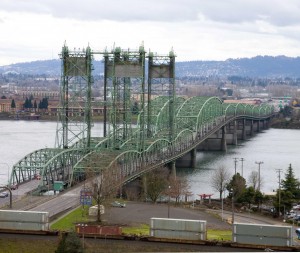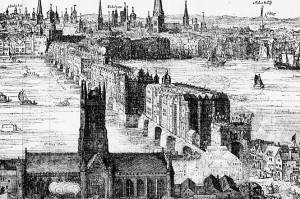
By Bob Hicks
Once again the fates have flung Mr. Scatter to the far reaches of Ecotopia, where yet another dismal drive through the 90-mile sprawl of the great Seattle megalopolis has underscored how little eco is left in this topia of ours. They paved Paradise and put up a freeway that’s a parking lot.
Well, sometimes you need a car. And cars need roads. And roads, when they run up to little impediments like the mighty Columbia River, need bridges. And bridges, we hear, can cost a cool four billion bucks. And four billion bucks (plus interest), we understand, will be coming out of everyman’s collective wallet for a long, long time to come.
 Up to now Mr. Scatter has stayed out of the fray over the Columbia River Crossing bridge, the proposed replacement for the aging Interstate-5 span between Portland and Vancouver, Wash. Should the bridge be an architectural icon, a splendid work of art? Should it be a utilitarian get-‘er-done, a cheap and (presumably) practical slab of concrete designed to move the traffic and not much else? Truth is, Mr. Scatter doesn’t really know, although he’s grouchily beginning to ask himself a more basic question: Do we really need to bother with the damned thing at all?
Up to now Mr. Scatter has stayed out of the fray over the Columbia River Crossing bridge, the proposed replacement for the aging Interstate-5 span between Portland and Vancouver, Wash. Should the bridge be an architectural icon, a splendid work of art? Should it be a utilitarian get-‘er-done, a cheap and (presumably) practical slab of concrete designed to move the traffic and not much else? Truth is, Mr. Scatter doesn’t really know, although he’s grouchily beginning to ask himself a more basic question: Do we really need to bother with the damned thing at all?
He knows, he knows: rush hour traffic is getting intolerable, and rush hour itself is getting longer and longer all the time. And we need a dedicated light rail lane, and a good wide swath for all those multiple thousands of interstate bicycle commuters dodging pot holes as they duck Oregon taxes. And the current bridge (it’s twin bridges, actually, side by side) is fraying, and demand will only get steeper, and it’s the worst bottleneck for freight-truck traffic between the Mexican and Canadian borders, and …
But he also knows this: the true bottleneck isn’t the bridge itself, but the inadequate approaches on the Oregon side, and what is the answer to that — rip up yet another neighborhood to widen the freeway? At what cost in dollars and irreparably shattered urban cohesion? He thinks this every time he’s in a city like Vancouver, British Columbia, or San Francisco, or Manhattan, where the freeways are largely lopped off at the entrances and neighborhood life is bustling.
And he knows this: more lanes inevitably mean more traffic and more sprawl. (And a third bridge on the west side, which might be a more practical alternative to a bigger and better I-5 bridge except that it would also mean more dead zones at its approaches on either side of the river, would inevitably mean more sprawl in the western suburbs of both states.)
 He wonders this: Is it a good idea to encourage even more sprawl in Clark County, where Vancouver remains a core city waiting to happen while fertile farmland gives way to more and more widely strewn getaways for people who drive daily to work in Portland?
He wonders this: Is it a good idea to encourage even more sprawl in Clark County, where Vancouver remains a core city waiting to happen while fertile farmland gives way to more and more widely strewn getaways for people who drive daily to work in Portland?
And he wonders this: if the big problem is that it’s tough for trucks carrying interstate commerce to get through the bottleneck — a problem that is clearly a federal problem, since the commerce is going through, not to, Portland and Vancouver — why aren’t the feds paying for the solution? (And more fundamentally: Why isn’t a far greater proportion of interstate freight routed through rail lines rather than the freeway system, with local trucking fanning out to local customers?)
Mr. Scatter understands that people need places to live, and a good transportation system moves people from one place to another as cheaply and swiftly and efficiently as possible. He also understands that he does not fully comprehend or appreciate the complex whirrings and clackings of the great and wise American political machine, which grinds out solutions to perplexing social difficulties like so much sausage. He admits that he is a romantic naif in matters infrastructural compared to bracing men of action such as Robert Moses, and concedes that no matter what he thinks, some sort of grand new span is going to get built, with a boggling bill for mere taxpayers attached.
Still, speaking of bridges, he can’t help but wax a little nostalgic about a freeway plan he once felt he could actually get behind: former Portland Mayor Vera Katz’s short-lived proposal to cap the I-405 freeway that slashes between the city’s downtown and its western end. People laughed at Katz and basically hooted the proposal off the stage, yet in fact her plan was minimal: just two and a half blocks at an estimated (no doubt underestimated) cost of about $10 million. But the idea behind the idea was audacious and visionary. In effect it could have turned the freeway into a tunnel and created a new surface that would have reconnected broken neighborhoods, re-created urban fabric and spurred an untold amount of economic growth. The price tag for a full-bore extension of the cap and revitalization of the re-elevated “land” it would have created? Mr. Scatter doesn’t know. He imagines it was impractical. But if it was four billion bucks, it would have been four billion bucks of something.
 Then Mr. Scatter read Bill Bryson‘s short 2007 biography Shakespeare: The World as Stage, an engaging examination of the life and culture of Elizabethan and Jacobean England, and he laughed at himself, because as it turns out, the idea of a bridge teeming with urban life and commerce is a very old one. Shakespeare is a fine and sensible and even funny book, and Mr. Scatter apologizes to Mr. Bryson for picking it up from a remainder bin at Powell’s for $8.98 instead of paying the full $19.95. Here’s what Bryson has to say about the legendary London Bridge:
Then Mr. Scatter read Bill Bryson‘s short 2007 biography Shakespeare: The World as Stage, an engaging examination of the life and culture of Elizabethan and Jacobean England, and he laughed at himself, because as it turns out, the idea of a bridge teeming with urban life and commerce is a very old one. Shakespeare is a fine and sensible and even funny book, and Mr. Scatter apologizes to Mr. Bryson for picking it up from a remainder bin at Powell’s for $8.98 instead of paying the full $19.95. Here’s what Bryson has to say about the legendary London Bridge:
The bridge was already venerable when Shakespeare first saw it. It had been built nearly four centuries earlier, in 1209, and would remain the only span across the river in London for nearly two centuries more. Standing a little east of today’s London Bridge, it stretched more than nine hundred feet and was a little city in itself, with more than a hundred shops in scores of buildings of all shapes and sizes. The bridge was the noisiest place in the metropolis, but also the cleanest (or at least the best aired), and so became an outpost of wealthy merchants — a kind of sixteenth-century Bond Street. Because space was so valuable, some of the buildings were six stories high and projected as much as sixty-five feet over the river, supported by mighty struts and groaning buttresses. It even had its own precarious palace, Nonesuch House, built in the late 1570s, teetering at its southern end. By long tradition at the Southwark end of the bridge the heads of serious criminals, especially traitors, were displayed on poles, each serving as a kind of odd and grisly bird feeder. (The headless bodies were hung above the entrance gates to the city, or distributed to other cities across the realm.) There were so many heads, indeed, that it was necessary to employ a Keeper of Heads.
Mr. Scatter wonders idly if the Keeper of Heads kept the heads of state from losing theirs. He appreciates the symbiotic relationship among commerce, human habitation, and transportation on the old London Bridge (a span meant, it should be pointed out, for foot traffic and ox carts, not Priuses and tractor-trailer rigs). He concedes that his blood pressure rises as alarmingly as anyone else’s when he finds himself stuck in a traffic jam on a freeway. But he wonders, no doubt foolishly: if we must have a four billion dollar bridge, why can’t it be a four billion dollar bridge to somewhere, not through somewhere?
*
ILLUSTRATIONS, from top:
- Drawing of London Bridge from a 1682 London map. Surveyed by: Morgan, William, d. 1690. Published: London, London Topographical Society, 1904. Wikimedia Commons
- Interstate Bridge between Portland and Vancouver. Source: Cacophony/Wikimedia Commons.
- Detail from 1616 etching by Claes Van Visscher, showing Old London Bridge with Southwark Cathedral in the foreground. Wikimedia Commons.
- English edition of Bill Bryson’s “Shakespeare: The World as Stage.”